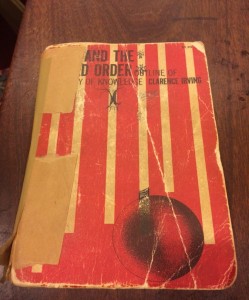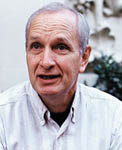Classic Review by Bruce Kuklick on a Long Affair with C.I. Lewis’s Mind and the World-Order (1929)
I first read C. I. Lewis’s Mind and the World-Order as a philosophy major in 1962. I read it in two classes. As a self-proclaimed pragmatist, I regarded the book and Lewis’s reputation as a logician as the best defense of “my” position. When, years later, I began writing about the history of pragmatism, he became my hero. I perused the book again and again, and taught it to graduate students through the 1970s. It led me to other thinkers, before and after Lewis. By the time I had moved on to different scholarship, I had begun having yearly lunches with Lewis’s elderly wife, a remarkable and gifted woman, and then started taking my daughter to these rendezvous’ in West Concord, Massachusetts. My daughter corresponded with “Mrs. Lewis,” some ninety years her senior, until Mabel Lewis died at 102, in the late twentieth century.
When I took the assignment to do an essay on Mind and the World-Order for the S-USIH, I had not opened “MWO” for some thirty-five years. I now found it clumsily composed, sometimes turgid, and relentlessly repetitive. Some of my favorite passages still gave me pleasure, but the commanding paragraphs that I most remembered do not actually crop up in any one place; they turned out to be my own selection and reorganization of several discussions from the volume.
What gave the work its power for me and for so many others? It is the vision. The machine shop of the author’s brain operates inelegantly — but it still operates and the vision still emerges.
Clarence Irving Lewis – his wife always referred to him as “C” — was a New England Protestant from a hard-scrabble background. By dint of a formidable intellect and intense labor, he got into Harvard, and doggedly applied himself. As a young academic, he produced the first American treatment of symbolic logic, which the Englishmen Bertrand Russell and Alfred North Whitehead had convincingly examined in Principia Mathematica. Lewis, however, did not follow the English. He uniquely contributed by discovering, or inventing, “modal” logic, the arena of the possible and the necessary, and not just the factually true or false. In his adulthood Lewis (and his wife) had an unbelievably painful personal life. Mabel Lewis sacrificed herself for her husband, and the marriage was strained. His oldest son, Irving, died as a small child; some years later leukemia killed his daughter Peggy, a beautiful young woman at college; a World War Two Pacific disease incapacitated a second son, David; only one of the couple’s four children, Andrew, survived to a successful maturity. A sophomore once confronted Lewis with the conventional subjectivist argument that there was no difference between good and bad.  Fighting tears, Lewis replied: “O yes there is.”
Fighting tears, Lewis replied: “O yes there is.”
Lewis’s early poverty, his rarified and abstract academic concerns, and his trials as a parent made him sober, even puritanical. He was austere, and an unsparing critic of even philosophers like Whitehead and Peter Hempel. He was not the sort of person to invite to dinner to secure a witty and vivacious guest. Lewis was on a serious mission that no socializing would interrupt.
The mission was epistemology. He would lay out a comprehensive theory of knowledge, a consideration of the nature and range of the knowing faculty, the nature of the object known, and the relation between the two. His approach was consistent with his logic, and Mind and the World-Order and his later An Analysis of Knowledge and Valuation (1946) are the most sustained, systematic examples of philosophy published in the United States.
We encounter in experience “the given,” elemental sensuous content, that we must manage in order to prosper. We approach it with intertwined ideas, concepts, beliefs, or categories that define the mind’s contribution to knowledge, and that are independent of the given. Knowledge requires both of these constituents, mind and given, and the dynamic partnership results in our grasp of a world of objects. Ideas are connected plans for undergoing and doing: they prescribe that on the appearance of a certain sort of given component, if we proceed in thus and such a way, a certain further component of the given will come into view. Take, for instance, an idea of a chemical element. Presented with a constellation of impressions, we imply that if we put a sample of a presumed element into an acid, a reaction will take place; that a different reaction will occur if we put it in water; that if we go to the jewelry store, we can sell it for a great deal of money; and on and on.
We rightly comprehend concepts not as entities in the head, but as dispositions to action in ordered settings. Concepts are programs involving our active attitudes toward life and our desire to achieve certain goals over a span of time; they define how we are to conduct ourselves in engaging the given.
When our guided performances have their expected outcomes in the given, we verify individual beliefs, and are on our way to probable knowledge. But when the given systematically frustrates linked beliefs, we more appropriately say not that the beliefs are falsified, but that we have withdrawn them from service.
The pragmatic aspect of knowledge resides in this mutation of categories as they become more or less useful for the purposes they were designed to serve. Nonetheless, Lewis also urges that empirical confirmation – by the presence or absence of expected ingredients of the given – plays a role in the rise and fall of schemes of categories.
Lewis disliked the unsubtle views of logical positivism, the dominant scientific philosophy of the twentieth century, but he respected progressive experimental knowledge. At the same time, his notion of altering constructs looked toward the post-modern. With his emphasis on the mind’s task in knowledge, Lewis was indebted to Kant. Yet Lewis updated Kant by noting the relativizing function of our local and goal-oriented social inheritance – culture — in the formation of our understanding. To serve our needs, we construct our world, but it simultaneously constrains the construction.
Lewis was the most influential person in the American discipline of philosophy in the twentieth century, and the twenty-first century specialties of modal logic, counterfactuals, and possible world theory have their origins in his efforts. Henry Kissinger’s repeated demands for “a conceptual frame” for foreign policy hearken back to Lewis, as does the still fashionable notion of a “paradigm shift” that some folks mistakenly think originated with Thomas Kuhn. Most of all, I believe, Lewis lives for many undergraduate who take a class in Kant. American professors had taught Kant before Lewis, but at Harvard he institutionalized such study and, in particular, the reading of Kant’s Critique of Pure Reason in this class. Lewis’s students, and then their students, and then even students after them, continued to teach that text as Lewis had. Fewer than ten years ago, in a course on Kant, one of my sons learned the Critique from someone who had been taught by someone, who had been taught by someone… and on back to Lewis.
Lewis saw into the dark, and I was lucky the man entered my life.
Bruce Kuklick is Nichols Professor of American History Emeritus at the University of Pennsyl vania. He is the author of many books on US cultural, political, and diplomatic history, including several on the history of American philosophy. His latest book, with Emmanuel Gerard, is Death in the Congo: Murdering Patrice Lumumba (Harvard, 2015). He is at work on a history of the five Sullivan brothers from Waterloo, Iowa, who were killed in World War Two.
vania. He is the author of many books on US cultural, political, and diplomatic history, including several on the history of American philosophy. His latest book, with Emmanuel Gerard, is Death in the Congo: Murdering Patrice Lumumba (Harvard, 2015). He is at work on a history of the five Sullivan brothers from Waterloo, Iowa, who were killed in World War Two.

0